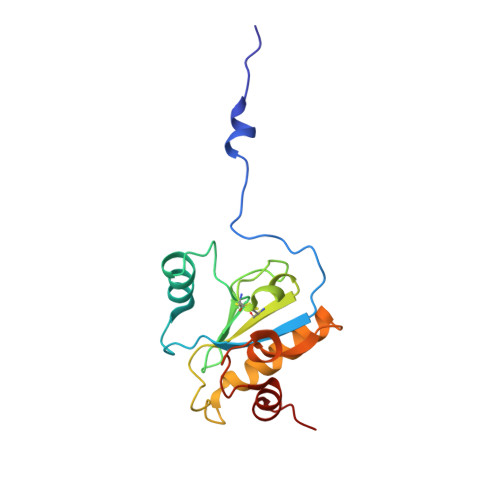Structure and function of the Ts2631 endolysin of Thermus scotoductus phage vB_Tsc2631 with unique N-terminal extension used for peptidoglycan binding.
Plotka, M., Sancho-Vaello, E., Dorawa, S., Kaczorowska, A.K., Kozlowski, L.P., Kaczorowski, T., Zeth, K.(2019) Sci Rep 9: 1261-1261
- PubMed: 30718611
- DOI: https://doi.org/10.1038/s41598-018-37417-6
- Primary Citation of Related Structures:
6FHG - PubMed Abstract:
To escape from hosts after completing their life cycle, bacteriophages often use endolysins, which degrade bacterial peptidoglycan. While mesophilic phages have been extensively studied, their thermophilic counterparts are not well characterized. Here, we present a detailed analysis of the structure and function of Ts2631 endolysin from thermophilic phage vB_Tsc2631, which is a zinc-dependent amidase. The active site of Ts2631 consists of His30, Tyr58, His131 and Cys139, which are involved in Zn 2+ coordination and catalysis. We found that the active site residues are necessary for lysis yet not crucial for peptidoglycan binding. To elucidate residues involved in the enzyme interaction with peptidoglycan, we tested single-residue substitution variants and identified Tyr60 and Lys70 as essential residues. Moreover, substitution of Cys80, abrogating disulfide bridge formation, inactivates Ts2631, as do substitutions of His31, Thr32 and Asn85 residues. The endolysin contains a positively charged N-terminal extension of 20 residues that can protrude from the remainder of the enzyme and is crucial for peptidoglycan binding. We show that the deletion of 20 residues from the N-terminus abolished the bacteriolytic activity of the enzyme. Because Ts2631 exhibits intrinsic antibacterial activity and unusual thermal stability, it is perfectly suited as a scaffold for the development of antimicrobial agents.
Organizational Affiliation:
Laboratory of Extremophiles Biology, Department of Microbiology, Faculty of Biology, University of Gdansk, Gdansk, Poland. magdalena.plotka@biol.ug.edu.pl.















